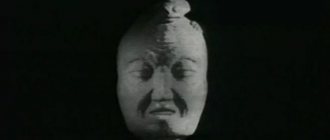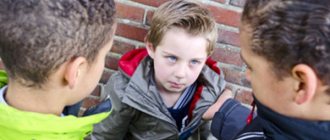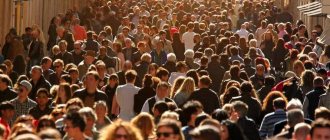What is demophobia, ochlophobia or agoraphobia and their differences
What is the name of the phobia? Agoraphobia, demophobia, ochlophobia. Let's try to understand the differences between these concepts.
What is agoraphobia? This is a fear of open space, or a fear of squares. But what frightens a person is not so much the square itself as the fact that he will feel bad, and no one will be able to help or will not notice it. That is, we can say that he is frightened by the reaction and behavior of the crowd.
Demophobia is the fear of large crowds of people. For example, a person is frightened by rallies, traveling on public transport, queues, etc. This is a fear of a lot of people. Demophobes are frightened by any crowd of people.
Ochlophobia is the fear of random, unorganized crowds of people. This is the difference between an ochlophobe and a demophobe. The first one will not be frightened by a crowd of people who are united by at least some common goal, for example, they will not be frightened by museum visitors or a line at the ticket office. But a chaotic crowd of people in the subway or on the street frightens the ochlophobe.
Currently, all three names are used as synonyms for each other. It is believed that ochlophobia and demophobia are outdated names for agoraphobia. It is also generally accepted that there is a slight difference between ochlophobia and demophobia, which will be interesting and important only for a psychiatrist during diagnosis. In general, the mechanism of development, manifestations and methods of treatment are the same for all three phobias.
What is an ochlophobe afraid of? Behind each of these phobias lies the fear of losing control, being in danger, or dying. A person cannot be responsible for the actions of all members of the crowd, and this frightens him; he feels vulnerable and helpless.
Terminology
What is the fear of crowds called? This question is far from being as simple as it seems at first glance. There are several variants of panic fear of large crowds of people, which differ in the types of stimuli:
- Ochlophobia is an uncontrollable fear caused by interaction with an unorganized crowd of people.
- Demophobia is panic attacks that develop when being in public places. Visiting educational institutions, shops and restaurants becomes a real problem for carriers of this phobic disorder.
According to experts, these types of pathological fear are synonyms, the difference between which lies in the form of organization of the crowd of people with whom the bearer of the phobia is forced to interact. Unlike a demophobe who experiences a feeling of discomfort in a cinema or supermarket, an ochlophobe suffers from panic attacks while attending concerts, rallies or while on public transport.
In addition to the above disorders, there is agoraphobia, which is a similar concept. This type of phobia manifests itself as a fear of open space. A panic attack can occur when going out unaccompanied. Psychologists say that this disorder is closely related to the above disorders.
People suffering from this disease have difficulty performing unplanned activities that involve contact with large numbers of people.
There is also social phobia, which is a pathological fear of others. The need for social interaction instills real horror in a social phobic. Such people experience an acute feeling of discomfort when communicating with strangers or when speaking in public. A severe form of pathology implies fear of the attention of others. Such a person cannot perform usual actions when thinking about what is the object of the gaze of others.
Each of the above mental disorders is closely related to its synonym. The main difference between these pathologies is the causes of their occurrence.
Demophobia – panic fear of crowds, large crowds of people
Causes and signs of fear of crowds
Fear of crowds develops for the following reasons:
- individual psychological characteristics;
- genetic factor;
- psychotrauma (a person or someone he knows got hurt in a crowd, got lost, etc.);
- learning from parents;
- suggestibility (movies and news from the media can frighten).
Ochlophobia often develops in people raised in overprotective families, where parents intimidated children and talked about the dangers of the world around them. Other personality traits in people with a phobia include low self-esteem, self-doubt, mistrust, anxiety, and dependence on other people’s opinions.
Depending on the severity of the development of the phobia, a demophobe is frightened by a large crowd of people in a cinema or at a concert, in a market square. That is, the difference in the scale of the crowd (number of people) at which manifestations of the phobia are observed. The manifestations themselves can be divided into physical, cognitive and behavioral. Physical symptoms appear directly upon meeting the object of fear, the rest are constantly present, and the strength of their manifestation depends on the severity of the phobia.
Physical manifestations
When meeting a crowd, a person experiences:
- headache;
- increased blood pressure;
- arrhythmia;
- feeling of suffocation;
- migraine;
- dizziness;
- nausea;
- disorientation;
- derealization (feeling of the unreality of what is happening);
- deterioration of attention and memory;
- panic attacks (fear and reactions that are uncontrollable).
In advanced stages of the disease, symptoms may occur at the mere thought of going to a crowded place or seeing a crowd on TV.
Cognitive signs
These signs are not always observed, and if they are noticeable, then during close communication with the patient. The main feature is a change in thinking. A person begins to aggressively perceive any crowded places, crowded places, cultural events. Even a queue at the store can make him angry.
Behavioral changes
Only when alone and at home does a person feel completely safe. As the phobia develops, behavioral symptoms become more noticeable. The transition to a solitary lifestyle occurs gradually:
- first, a person experiences irritation and anxiety when going to the supermarket, and therefore begins to go to the nearest stall;
- then the patient refuses any noisy entertainment, parties, walks;
- then he switches to virtual communication, preferring the computer to real people;
- After this, the patient finds remote work and orders food home.
How to Identify Crowd Fear
By nature, man is a social being. In complete solitude, without undergoing irreversible mental deformation, he most likely will not be able to. People are divided into extroverts and introverts. The first ones feel comfortable in a mass gathering, as they say, like a fish in water. The latter are more comfortable limiting their social circle and avoiding being in a crowd.
There are people who are not only uncomfortable being around a large number of people, they experience real panic. Psychologists know what this state of fear of crowds is called. Its name is demophobia. There is a concept close to this - ochlophobia. It denotes not just fear of society, but fear of an unorganized crowd that is difficult to control. A demophobe will be afraid of a crowded place, an ochlophobe will calmly go to a concert, but panic will overtake him on public transport.
Public transport is an example of an unorganized crowd
Along with these names, there is the concept of agoraphobia - fear of open space. Some experts consider it the only true one, calling demophobia either a synonym for it, or even an outdated concept. This happens because the mechanism for the appearance of these two phobias is approximately the same. Although the vast majority of psychologists distinguish between these concepts.
When characterizing demophobia, this unpleasant condition, it should be remembered that we are not talking about the stupid whim of a particular individual. This is a real disease. If for a healthy person society is simply the individuals around him, then a person with demophobia perceives society as nothing other than a single being aggressively opposed to him.
Important! You should perceive demophobia in a stranger adequately, without comparing it with yourself. What may seem like a trifle to one person is a tragedy on a life-scale scale to another person.
Main Characteristics of Crowd Fear
When diagnosing, it is important to distinguish pathological fear of crowds from healthy caution and personality traits. A person with demophobia has four characteristic features: increased emotionality, irrationality, uncontrollable emotions, and avoidance. Let's consider each of the points in more detail.
Excessive emotions
A person inclined to solitude is indifferent to the crowd, he simply tries to meet with it as little as possible. A person with a phobia gets irritated and angry when he gets into a crowd. He can show hostility and aggression, he condemns and criticizes passers-by, and sometimes experiences disgust. These feelings are characteristic of the initial stage of a phobia. As it develops, irritation gives way to panic and severe fear and anxiety.
Irrational attitude towards the crowd
Regardless of what a person experiences (anxiety or irritation), his reactions and attitude towards the crowd are irrational. That is, a person gets irritated for no apparent reason. For example, if you are in a hurry to go to work, and the road to the metro is blocked by a protesting crowd, then in this case the irritation is understandable. But if you are annoyed by a line in a store or just a busy street, then we are talking about a phobia. In most cases, the patient himself cannot even explain why the crowd frightens or irritates him.
Uncontrollable emotions
We are talking about those uncontrolled reactions and manifestations of phobia that arise upon contact with the object of fear. The more developed ochlophobia, the more unpredictable and uncontrollable reactions and emotions a person has.
Subconscious avoidance
Without noticing it, a person changes routes and work schedules, adjusts leisure time so as to minimize encounters with crowds. Over time, avoidance leads to reclusiveness.
Causes of panic fear
The appearance of such pronounced states always has its own background. As a rule, the prerequisites that give rise to demophobia are laid in childhood, when personal space and the child’s sense of it are formed. If it is constantly violated, the child may have problems with people in later life, especially if we are talking about a large concentration of them.
Such a child, growing up, will be more often exposed to traumatic situations that are associated with people or a group of people. And if, as an adult, he suffers severely from a crowd or simply from situations involving individuals, then he may develop demophobia.
Demophobia also occurs as a concomitant factor in mental illness and nervous disorders.
All those people with whom we travel in transport, walk down the street, are in a room are in invisible contact with us, we can experience an emotional reaction when looking at them, experiencing discomfort from human touches, smells, etc. These impressions can influence our personal space.
Each person has their own distance. By establishing it with other people and interacting with them, he feels safe. For demophobes, such a distance does not exist; they are extremely susceptible to others. A person whose boundaries have been constantly violated since childhood will feel great discomfort when surrounded by other people. With a large number of interactions, a person may have a constant desire to “run away” from the crowd, to be alone. If no measures are taken, this process will intensify, and tension in contact with people will increase. Don't expect intense fear to go away on its own. Symptoms that appear once will be repeated again and again. Help yourself in ways that you find acceptable.
Panic fear of crowds, like any other phobia, is a defensive reaction. It helps a person protect himself and his own borders. Highly sensitive people maintain their personal space by avoiding large crowds of people, choosing a small group of those with whom they feel comfortable.
How to deal with a phobia
Treatment of phobia involves psychotherapy sessions and medication (at an advanced stage, tranquilizers and sedatives are prescribed). Psychotherapy methods include cognitive behavioral psychotherapy and gestalt therapy.
It is important! Treatment of a phobia will proceed faster and better if the patient is supported by loved ones.
Independent work
The foundation of demophobia is laid in childhood. In most cases, crowd phobia is caused by destructive childhood attitudes and negative personal experiences. Perhaps a crowd of people is scary because it is associated with a violation of personal space, a ban on self-expression, and problems in the communication sphere. Analyze your childhood history and think about what is really hidden behind your fear of crowds. Make a self-correction plan and begin a gradual rapprochement with fear.
Psychologist's advice
General psychological tips will help pacify anxiety and fear:
- Lead a healthy lifestyle. Monitor your diet, sleep, work and rest patterns.
- Play sports. Regular, feasible exercise and walks have a positive effect on physical and mental health. With hundreds of sports activities available, you're sure to find something that suits you.
- Find a hobby that will become a constant source of positivity.
- Take relaxing baths or go for spa treatments.
- Solve all life problems in a timely manner, do not accumulate them.
- Do yoga, meditation, breathing exercises, or find your own way of relaxation.
- Meet with friends, join a thematic group.
- Don’t isolate yourself, force yourself to visit crowded places.
Crowd fear is associated with negative thinking and perception. The patient does not trust himself and others, sees only the bad in people, and is not confident in his abilities. Live in peace with your needs and desires, learn to see the good in people and radiate positivity yourself. To overcome a phobia, it is useful to engage in public affairs and charity work with other people.
Emergency assistance during an attack
What to do if you are overcome by fear:
- Look around. Stop evaluating the crowd as one dangerous mechanism, look at each person in it separately. Surely you will see that each of them is busy with their own business and does not pose a danger to you. Moreover, probably no one is paying attention to you. In a crowd, people are always preoccupied with themselves and their problems.
- Choose one person and contact him, for example, ask what time it is. This will help you understand that there are adequate people in the crowd.
- Focus on your breathing, your sensations. Take several deep, long breaths and deep, long exhalations. Feel the areas of your body where tension has accumulated. Tighten them even more and sharply relax them (method of relaxation through tension).
- Remember or imagine something pleasant, call a loved one. This will help you relax and calm down.
It is important to remember the psychological aspects of working in large crowds. To do this, you need to know the characteristics of the crowd as a single organism and the characteristics of human behavior in the crowd.
Psychological characteristics of the crowd:
- the short duration and lack of structure of crowds of people;
- general object of attention;
- lack of a common goal;
- high level of interaction between people within the crowd;
- increased emotionality and excitability;
- conformism.
Psychological characteristics of a crowd participant:
- anonymity,
- instinctiveness,
- unconsciousness,
- feeling of unity
- A state of trance,
- infectivity,
- feeling of omnipotence
- irresponsibility,
- amorphousness,
- social degradation.
Why is there a fear of crowds?
Fear of the dark - what is this phobia called, why does fear arise and how to fight it
Often, phobias originate in childhood, when the psyche of a small person is not strong and is more easily influenced by negative incidents. Speaking about demophobia, the fear of crowds, it cannot be said that it was acquired at a young age. Fear of crowds develops when a person perceives himself as an independent (at least to some extent) member of society.
More often it appears after some major negative incident in the crowd. A phobia can develop, for example, in survivors of a terrorist attack. The impetus for the development of the disease does not have to be so large-scale, but it is always difficult morally for the sick person. In fact, fear of society is a self-preservation instinct heightened to the limit.
Terrorist attack on public transport
Childhood problems can indirectly provoke the development of demophobia. Thus, a teenager with problems may, for example, be less resistant to stress or get lost in unexpected situations. This will lead to the fact that at the right moment he will not be able to react correctly, and an incident that seems insignificant at first glance will have such a strong impact on him.
Prevention
Preventive measures can be divided into primary and secondary prevention. Primary involves the care of parents for the child. Demophobia is a social phobia, a form of maladjustment. It is necessary to take care of the child’s socialization and help him develop communication skills. Secondary prevention is carried out in adulthood and involves people working independently on themselves. It is important to monitor your health, work through all injuries, and not suppress problems and negativity.
It is important! If you cannot cope with any traumatic situation on your own, then consult a psychologist.
Fear of strangers in children
Some people believe that only young preschool-aged children are afraid of strangers. Many mothers can remember such fears in their children that manifested themselves at the age of six months; the baby becomes hysterical when there are strangers nearby.
This is quite normal. At this age, this is associated with the intellectual development of the baby; it means that the child can recognize familiar and unfamiliar people.
Psychologists began to study this problem with children’s reactions to strangers. Psychologists during their experiments noted an interesting pattern.
When reactions to strangers were studied in eight-month-old children, it was noted that during the experiment both children and their mothers began to feel nervous, and the mothers had a higher level of anxiety. It was then that it was established that everyone experiences fear of strangers; this is a universal human reaction pattern.
This phenomenon can be compared to a person's reaction to a new and unknown phenomenon. Younger schoolchildren also experience these feelings and emotions. Meeting strangers causes anxiety and fear in both adults and children of any age. Mistrust is the main cause of fear. Psychological research and daily human experience suggest that communication between people who do not trust each other is not enjoyable, uncomfortable and ineffective.
At the same time, if a child unconditionally trusts unfamiliar adults, they can use this for their own purposes.
For example, if teachers or parents have lost sight of such a child for some time, there is a possibility that he will be in danger; he may be lured, the keys to the apartment taken away, or his money lured out. That is why adults themselves often sow fear in a child’s mind of strangers.
At the same time, parents do not even suspect that they are thereby imposing excessive anxiety on the child and sowing fear of communicating with strangers.
There is another common type of fear of strangers , which is expressed in the fear of asking something from a person on the street, even if it is quite important and necessary information.
The majority of the population, including schoolchildren and teenagers, will walk for a long time in unfamiliar places and would prefer to find the right place themselves rather than check with passers-by.
It is also difficult for them to buy something in a store, because they are afraid to talk with the seller, or they become silent at a doctor’s appointment, without answering a single question. Some children may experience fear in new, unfamiliar environments where they will have to communicate and meet new people. For such children, going to their parents’ friends, moving to another school, or talking on the phone is painful.











